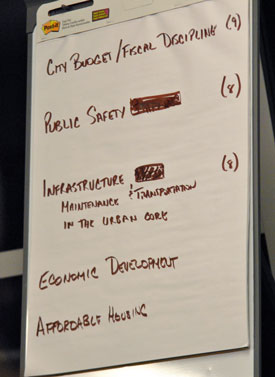Council Focus: Budget, Safety, Infrastructure
A key outcome of an Ann Arbor city council planning session held on Dec. 10 was the identification of five priority areas for the next year.
Three of the areas generated immediate consensus among the 11 councilmembers: (1) city budget and fiscal discipline; (2) public safety; and (3) infrastructure. Two additional areas were drawn from a raft of other possible issues as those to which the council wanted to devote time and energy: (4) economic development; and (5) affordable housing.

Five issues identified by the Ann Arbor city council as the areas they’d like to invest time and energy in the coming year: (1) city budget and fiscal discipline; (2) public safety; (3) infrastructure; (4) economic development; and (5) affordable housing. (Photos by the writer.)
Possibly more important than the five areas of focus were the answers councilmembers developed to two questions about each area: (1) What is the problem we are solving? and (2) What does success look like?
Based on remarks at the conclusion of the evening, councilmembers seemed almost universally enthusiastic with the outcome of the planning session, which was facilitated by Julia Novak of the Novak Consulting Group. Novak holds a masters degree in public administration from the University of Kansas – the same program where Ann Arbor city administrator Steve Powers obtained his degree. However, the two did not overlap there as students.
Marcia Higgins (Ward 4), who’d helped plan the format and content of the session during budget committee meetings over the last two months, said: “I think the engagement among councilmembers tonight was extraordinary.” She attributed that engagement at least in part to the fact that councilmembers were asked not to bring their laptop computers or cellphones to the session.
Margie Teall (Ward 4) felt that having an objective facilitator helped. And Christopher Taylor (Ward 3) thought that Novak did a good job keeping the council focused on not presupposing solutions, but rather on trying to clearly define what problem the council is trying to solve.
The general enthusiasm among councilmembers for the two-question approach that Novak took carried over to the work of a five-member city council committee on public art that met the following day. The group actively attempted to apply the problem/success approach to their work.
Somewhat dubious about one of the problem statements – in connection with public safety – was Sumi Kailasapathy (Ward 1), who still wondered at the end of the session about the implications of the word “optimize.”
This report includes the consensus problem/success statements for each of the areas of focus. The report also provides a more detailed look at how the council moved from an initial draft to its final consensus on one of those priorities – public safety. [Full Story]



